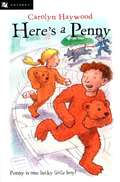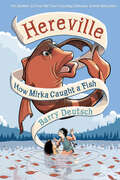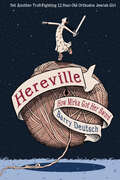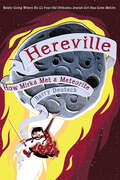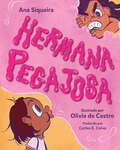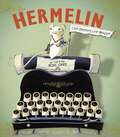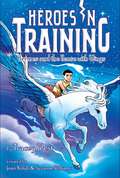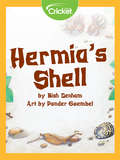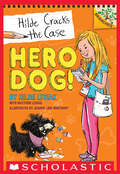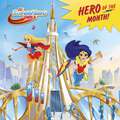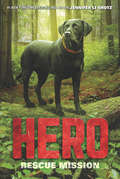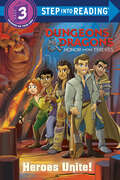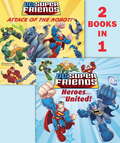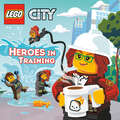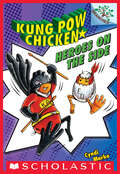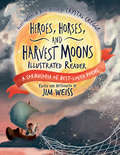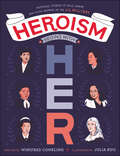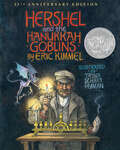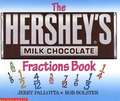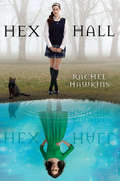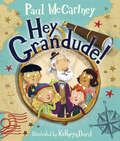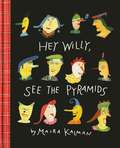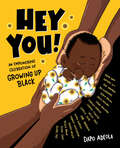- Table View
- List View
Here's a Penny
by Carolyn HaywoodFrom Carolyn Haywood, author of the beloved Betsy series, here are four more classics for young readers. These adorable stories of childhood adventures are as fresh today as when they were written more than a half century ago. And now, thanks to dynamic new covers, they're ready to charm a whole new generation of readers.Penny's name is really William, but when he was adopted as a baby, he had hair the color of a new copper penny. Adopted or not, Penny decides to prove his friend Patsy wrong when she says he doesn't truly have a family!
Hereville: How Mirka Caught a Fish
by Barry DeutschThe Orthodox Jewish heroine of Hereville must save her sister from a malevolent magic fish in this “consistently clever” preteen graphic novel series (Kirkus).Welcome back to Hereville, where Mirka, the world’s first time-traveling, monster-fighting Orthodox Jewish girl, faces her greatest challenge yet: babysitting! Mirka just wants to find new adventures, but instead she’s stuck babysitting her disapproving little sister, Layele. When Mirka pushes her sister into a stream, they both get in too deep with an angry magic fish. No matter how hard Mirka fights this fish-out-of-water, it gets stronger and stronger—and it’s out for revenge. Mirka is in over her head, and this time, her whole family is on the line! When the fish kidnaps Layele, Mirka must find a way to save her little sister, and the clues she needs are hidden in her stepmother Fruma’s past. Mixing fantasy, adventure, cultural traditions, squabbling siblings, and preteen commotion, Hereville: How Mirka Caught a Fish is sure to captivate readers with its exciting visuals and indomitable heroine.
Hereville: How Mirka Got Her Sword (Hereville)
by Barry DeutschA young Orthodox Jewish girl embarks on a fantastical adventure in this acclaimed graphic novel for preteens—“a terrific story, told with skill” (Publishers Weekly, starred review).Spunky, strong-willed eleven-year-old Mirka Herschberg isn’t interested in knitting lessons from her stepmother, or how-to-find-a-husband advice from her sister, or you-better-not warnings from her brother. There’s only one thing she does want: to fight dragons!Granted, no dragons have been breathing fire around Hereville, the Orthodox Jewish community where Mirka lives. But that doesn’t stop the plucky girl from honing her skills by fearlessly stands up to local bullies. She battles a very large, very menacing pig. But when she boldly accepts a challenge from a mysterious witch, Mirka might finally get her very own dragon-slaying sword! All she has to do is find—and outwit—the giant troll who’s got it!A delightful mix of fantasy, adventure, cultural traditions, and preteen commotion, Hereville will captivate middle-school readers with its exciting visuals and entertaining new heroine.
Hereville: How Mirka Met a Meteorite (Hereville)
by Barry DeutschIn this “truly clever” graphic novel series, the Orthodox Jewish heroine of Hereville meets her match—a magical doppelgänger of herself (Kirkus, starred review).Mirka is back, and she’s still the only sword-brandishing, monster-fighting Orthodox Jewish girl in town. Or so she thinks. When a misguided troll aims a meteor at Hereville, the local witch grabs the closest thing available to transform the flying, flaming rock—and that would be Mirka’s hair. The meteor is changed, all right: it’s now Mirka’s identical twin. Doppelganger Mirka, vowing to be a better version of the real girl, sets out to charm all of Hereville, including Mirka’s own family. Our heroine challenges the meteor girl to a three-part contest . . . and the loser will be banished from Hereville forever!A delightful mix of fantasy, adventure, cultural traditions, and preteen commotion, this fun, quirky graphic novel series will captivate middle-school readers with its exciting visuals and entertaining new heroine.
Hermana pegajosa (Spanish Edition)
by ANA SIQUEIRA¡Tener a una hermana que quiere hacer todo juntas es una molestia! Pero al final, las hermanas mayores y las hermanas menores siempre encuentran una manera de reconciliarse. Un libro ilustrado divertido para leer en voz alta que está lleno de humor y corazón; perfecto para niños de 3 a 7 años con un hermano o una hermana menor o mayor.Having a sister who wants to do everything together is a pain! But in the end, big and little sisters always find a way to make up.A fun read-aloud picture book that&’s full of humor and heart and perfect for 3-7-year-olds with a younger or older sibling.Claudia es la hermana mayor. Mónica es la hermana menor. Tenerse la una a la otra es divertido. Hacen burbujas de chicle donde cada una sopla una burbuja y casi las juntan en forma de signo de paz.Pero, a veces, Mónica es demasiado pegajosa—queriendo hacer todo lo que Claudia hace. Y Claudia finalmente pierde la paciencia cuando Mónica trata de ir a su torneo de fútbol. Ella le dice a su hermana menor que hay un monstruo que se come a los niños pequeños. Luego, como hacen los hermanos, resuelven sus problemas y se reconcilian.Pero cuando las burbujas de chicle salen mal, ¡le dan un significado nuevo a la palabra &“pegajosa&”!También disponible en inglés como Sticky Hermana.Claudia is the big sister. Monica is the little sister. Having each other is fun. They do bubblegum peace bubbles, where they each blow a bubble and almost touch them together.But sometimes Monica is just way too sticky—wanting to do everything Claudia does. And Claudia finally loses it when Monica tries to come to her soccer tournament. She tells her little sister that there&’s a monster that eats little kids. Then, just like siblings do, they work it out and make up.But when those bubblegum peace bubbles go awry, it brings an entirely new definition to the word sticky!Also available in English as Sticky Hermana.
Hermelin the Detective Mouse
by Mini GreyRatatouille meets Sherlock Holmes in this heartwarming story of mystery and adventure, acceptance and friendship, by the acclaimed creator of Traction Man and Toys in Space. Hermelin is a special little mouse. He was born in a box of cheese and lives in an attic at 33 Offley Street. He can read books and type notes on his typewriter. Most importantly, Hermelin can solve mysteries. And the people of Offley Street are in need of a detective! Again and again, Hermelin is on the case—the anonymous hero. But when his neighbors invite him to a thank-you party in his honor and find out who Hermelin really is—a MOUSE!—will he still be welcome on Offley Street?
Hermes and the Horse with Wings (Heroes in Training #13)
by Joan Holub Suzanne Williams Tracey West Craig PhillipsZeus and the Olympians are tasked with finding a magical horse in this Heroes in Training adventure.When Zeus meets a young boy named Hermes, he claims to have their next quest from Pythia, the Oracle at Delphi. But he wants something for the information: Zeus must hand over the winged sandals he took from Perseus after their last battle. What he doesn’t know is that Perseus had stolen those sandals from someone…Hermes! Could those sandals be another magical object? When Hermes starts to fly, Zeus knows they have found another Olympian for their group—and Hermes lets Zeus know their next adventure will be to “find the force that sings.” Since Pythia never tells them exactly the right words (her glasses tend to get a little foggy), they figure out that they are supposed to find “the horse with wings.” With the help of a reluctant Hermes and another new boy named Ron, the Olympians are off in search of a winged horse—with a few surprises along the way!
Hermia's Shell
by Bish DenhamHermia the hermit crab needs a new shell. Her old shell is getting a bit tight.
Hero Dog!: A Branches Book (Hilde Cracks the Case #1)
by Joanne Lew-Vriethoff Matthew Lysiak Hilde LysiakPick a book. Grow a Reader! This series is part of Scholastic's early chapter book line Branches, aimed at newly independent readers. With easy-to-read text, high-interest content, fast-paced plots, and illustrations on every page, these books will boost reading confidence and stamina. Branches books help readers grow! 9-year old crime reporter, Hilde Lysiak, is starring in her very own early chapter book series -- inspired by news stories Hilde wrote in real life! In this first book, there's been a break-in on Orange Street! Cupcakes have been stolen, and soon a pie goes missing, too. Hilde and her sister/photographer, Izzy, must interview witnesses and follow the clues. Can Hilde crack the case in time to post her news story online? Joanne Lew-Vriethoff's personality-filled illustrations appear on every page, bringing Hilde's adventures to life for young readers!
Hero of the Month! (Pictureback(R))
by Mona MillerMeet WONDER WOMAN™, SUPERGIRL™, BATGIRL™, and all the other DC Super Hero Girls™! At Super Hero High, the galaxy&’s most powerful teens develop their powers and learn what it means to be a hero. Meet Wonder Woman, Supergirl, Batgirl, and all the other DC Super Hero Girls in this information-packed book that will introduce young fans to their favorite super heroes—especially those who have earned the biggest honor: the Hero of the Month award!
Hero: Rescue Mission (Hero Ser. #3)
by Jennifer Li ShotzThe adventure continues in the third installment of the #1 New York Times bestselling Hero series by Jennifer Li Shotz.Ben and Hero, the incredible search-and-rescue dog, have saved the day before—but never like this. Ben’s town is in trouble when two convicts escape from a nearby prison. His dad, a police officer, sets off to find the men and bring them to justice, but then Ben’s dad disappears and the trail goes cold.Ben knows that it’s up to him and Hero to solve the case. As they embark on their most dangerous mission yet, the two best friends must stock up on their bravery and courage in order to outwit the fugitives and bring Ben’s dad home. Are the two heroes up to the challenge?Get ready for another canine adventure full of danger, loyalty, and the unbreakable bond between a boy and his best friend.
Heroes Unite!: Honor Among Thieves) (Step into Reading)
by Nicole JohnsonThis Step 3 Step into Reading leveled reader is based on the film Dungeons & Dragons: Honor Among Thieves – in theaters March 3, 2023!Dungeons & Dragons: Honor Among Thieves is an upcoming high-fantasy heist film based on the popular role-playing game! Co-written and co-directed by Jonathan Goldstein and John Francis Daley (Spider-Man: Homecoming, Game Night), and produced by Jeremy Latcham (Spider-Man: Homecoming, Guardians of the Galaxy), the film stars Chris Pine, Michelle Rodriguez, Hugh Grant, Regé-Jean Page, Justice Smith, and Sophia Lillis. Kids ages 5 to 8 will love this Step 3 Step into Reading leveled reader based on the feature film.Step 3 readers feature engaging characters in easy-to-follow plots about popular topics. They are for children who are ready to read on their own.
Heroes United!/Attack of the Robot (Pictureback(R))
by Random House Dc ComicsJOIN SUPERMAN, BATMAN, THE FLASH, and all the DC SUPER FRIENDS as they battle an evil robot and use teamwork to save the day! This deluxe Pictureback features two action-packed stories, plus four pages of punchout characters and backgrounds for kids to create their very own DC SUPER FRIENDS adventures!
Heroes for Civil Rights
by David A. Adler Bill FarnsworthDr. Martin Luther King, Jr. , civil rights leader. Fannie Lou Hamer, founder of the Mississippi Freedom Democratic Party. The Little Rock Nine, pioneers in social integration. Whether marching, speaking, or simply going to school, these brave men and women fought to advance social justice. David A. Adler's moving biographies and Bill Farnsworth's evocative paintings honor these Americans who risked their own lives so that others could enjoy their rights.
Heroes in Training (Pictureback(R))
by Random HouseAn all-new storybook about the LEGO® City firefighters--plus 30 brick-tastic stickers! Children 4 to 7 will love to read about their favorite LEGO® City firefighters as they learn what it means to be everyday heroes as they practice new skills and try out new equipment in this full-color storybook--plus 30 brick-tastic stickers! LEGO City delivers reality-based role-play and building fun. LEGO City is all about REAL action, REAL fun, and REAL heroes. It can be seen on Nickelodeon, Netflix, and Amazon.
Heroes of the Surf
by Elisa CarboneAdventure on the high seas! WHAM! The Pliny jolts as if Black Beard himself has just punched her in the belly. Pedro and I slide and smack--bang--into the bulwark. "We're grounded," cries the first mate. "We've hit a shoal!" In May of 1882, a large steamship ran aground off the coast of New Jersey. Elisa Carbone imagines what it was like for two boys on that ship: waking up in the middle of the night, waves crashing over the side, the storm too big to lower the lifeboats. And then the flashing of light from shore--the surfmen, true "heroes of the surf," come to rescue them. The award-winning author's meticulous research combined with Nancy Carpenter's spectacular illustrations make this thrilling adventure on the high seas one not to be missed!
Heroes on the Side (Kung Pow Chicken #4)
by Cyndi MarkoEveryone’s favorite avian superhero must rescue the world’s sidekicks from a dastardly chicknapper in this action-packed, illustrated chapter book.Gordon Blue and his brother Benny are taking a trip to New York City. That means superhero Kung Pow Chicken and his sidekick, Egg Drop, will be there! Egg Drop gets invited to a big sidekicks party. But it is a trap! Bad guy Ticklebeak and his Bad Eggs chicknap all of the world’s sidekicks! Can Kung Pow Chicken save the sidekicks? Or will this hero crack under pressure?Praise for Let’s Get Cracking!“A perfectly puntastic page-turner. Hybrids of comics and traditional pictures, the goofy all-color illustrations propel the fast-moving, high-interest story. ‘Ham and eggs’—you don’t want to miss this!” —Kirkus Reviews, starred review “Just the thing for beginning readers.” —Publishers Weekly“Step aside, Captain Underpants! There is a new hero in town—this time, with feathers. . . . Fresh, funny, and packed with full-color illustrations, this new transitional series will be an instant hit with readers looking for silly fun and a touch of mystery.” —Booklist
Heroes, Horses, and Harvest Moons Illustrated Reader: A Cornucopia Of Best-loved Poems (A Cornucopia of Best-Loved Poems #0)
by Jim Weiss Crystal CreggeClassic poems about nature, bravery, love, and the wild journeys of the imagination, beautifully illustrated by Crystal Cregge.
Heroism Begins with Her: Inspiring Stories of Bold, Brave, and Gutsy Women in the U.S. Military
by Winifred ConklingFor fans of Rad American Women A–Z, Rebel Girls, and Women Who Dared comes an inspiring collection of more than 80 profiles about the brave women in the US military who fought hard for their country and even harder for what they believed in.From the Revolutionary War to present day, women have proudly served in the United States Army, Navy, Air Force, Marines, and Coast Guard as nurses, pilots, engineers, soldiers, and more. They dressed as men, worked for little pay and no benefits, and endured prejudice to break down barriers and earn their place beside their fellow servicemen. The achievements and courageous acts of these women forever changed the way the military operates!From well-known women to unsung heroes, this beautifully illustrated book tells incredible, captivating tales of gutsy women like Margaret Corbin, Harriet Tubman, Tammy Duckworth, and countless others.And it will prove just one thing: Women really can do anything!
Hershel and the Hanukkah Goblins: 25th Anniversary Edition
by Eric A. KimmelThe classic Hanukkah tale, shared by families all around the world-- now available in a beautiful anniversary edition. A Caldecott Honor book. An original tale featuring a traditional Jewish folk hero, this clever story, which received a Sydney Taylor Honor, has been a family favorite for decades. On the first night of Hanukkah, a weary traveler named Hershel of Ostropol eagerly approaches a village, where plenty of latkes and merriment should warm him. But when he arrives not a single candle is lit. A band of frightful goblins has taken over the synagogue, and the villagers cannot celebrate at all! Hershel vows to help them. Using his wits, the clever trickster faces down one goblin after the next, night after night. But can one man alone save Hanukkah and live to tell the tale? Trina Schart Hyman&’s leering goblins are equal parts terrifying and ridiculous as they match wits with Hershel, trying to keep him from lighting the menorah and celebrating Hanukkah. This beautiful 25th Anniversary Edition includes an insightful afterword from the author and publisher explaining the book's origins, and remembering Trina Schart Hyman, the illustrator who brought the tale to life. This classic picture book is a perfect Hanukkah gift and a wonderful read-aloud. For more tales of this clever folk hero, read The Adventures of Hershel of Ostropol— another collaboration between master storyteller Eric A. Kimmel and Trina Schart Hyman. Caldecott Honor Book ALA Notable Children&’s Book NCTE Notable Children&’s Book in the Language Arts A Sydney Taylor Award Honor Book Colorado Children&’s Book Award Washington Children's Choice Picture Book Award
Hershey's Milk Chocolate Fractions Book
by Jerry Pallotta Rob BolsterA Hershey's bar is made up of 12 little rectangles, making it the perfect edible tool for teaching fractions!
Hex Hall: To Be Recycled - Duplicate Isbn (A Hex Hall Novel #1)
by Rachel HawkinsThree years ago, Sophie Mercer discovered that she was a witch. It's gotten her into a few scrapes. Her non-gifted mother has been as supportive as possible, consulting Sophie's estranged father???an elusive European warlock???only when necessary. But when Sophie attracts too much human attention for a prom-night spell gone horribly wrong, it's her dad who decides her punishment: exile to Hex Hall, an isolated reform school for wayward Prodigium, a.k.a. witches, faeries, and shapeshifters.
Hey Grandude!
by Paul McCartneyThis #1 New York Times bestselling picture book adventure from Paul McCartney is perfect for Father&’s Day or any day when you&’re looking to celebrate the fun that grandparents and grandkids can get up to!See the compass needle spin, let the magic fun begin!Meet Grandude--a super-cool grandfather who is an intrepid explorer with some amazing tricks up his sleeve. Grandude is a one-of-a-kind traveler! With his magic compass, he whisks his four grandkids off on whirlwind adventures, taking them all around the globe. Join them as they ride flying fish, dodge stampedes, and escape avalanches! Brought to life with gloriously colorful illustrations from talented artist Kathryn Durst, Hey Grandude is the perfect bedtime story for little explorers and an ideal gift for Father&’s Day.
Hey Willy, See the Pyramids
by Maira KalmanNighttime is the best time for stories. And Lulu is the best storyteller. She knows about the three cross-eyed dogs at a fancy restaurant, about blue and green mountains where fish fly, about the family party where Maishel Shmelkin forgot to wear his pants and of course about the noodle woman the pointy red nose. The stories, told by a sister to her little brother, are short and sweet and make you remember things and forget things. Maira Kalman paints a wondrous and humor-filled world in a childs-eye view. It is full of wild invention, people familar and outlandish, bittersweet moments and flights of fancy.
Hey You!: An Empowering Celebration of Growing Up Black
by Dapo AdeolaThis remarkable picture book is a lyrical, inspirational exploration of growing up Black, written by award-winning illustrator Dapo Adeola, and brought to life by some of the most exciting Black artists of today.Remember to dream your own dreams Love your beautiful skin You always have a choice This book addresses--honestly, yet hopefully--the experiences Black children face growing up with systemic racism, as well as providing hope for the future and delivering a message of empowerment to a new generation of dreamers. It's a message that is both urgent and timeless--and offers a rich and rewarding reading experience for every child. To mirror the rich variety of the Black diaspora, this book showcases artwork from Dapo Adeola and eighteen more incredible Black illustrators in one remarkable and cohesive reading experience.
